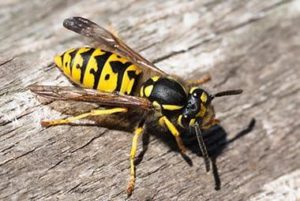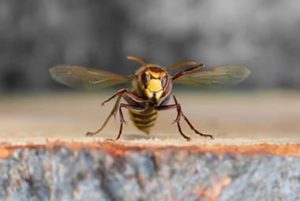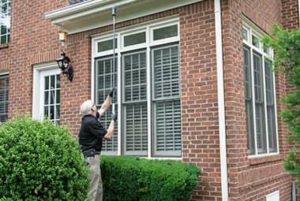Because East Tennessee season changes are so unpredictable, it’s probably a good time to address any cold weather maintenance projects now before the spring sun wakes up the hibernating insect population. With that in mind, let’s revisit carpenter bees and discuss what you could be doing to prepare for them now even though they may not emerge for a few weeks.
You remember carpenter bees, right? They’re the large, loud bees that like to hover near your head when you’re enjoying the spring sunshine. Homeowners will often encounter carpenter bees on their decks. This is because carpenter bees are wood-dwellers, so they probably have nests in the deck, or the porch rails, or the wooden siding. It is quite unusual for carpenter bees to sting, but they’re still unpleasant and potentially damaging companions.
Although carpenter bees are not considered as destructive as termites, they can really do a number on your wooden structures. You may only see a few holes (although a badly infested location may have dozens of holes), but the nests behind those entrances can easily go on for over ten feet through your board or plank! Taking care of these creatures early can save you a lot of grief later when you have to treat for the bees and replace the wood that they destroyed.
What you may not realize is that carpenter bees are practical creatures, so they often re-use and expand the nests that they were born in when making plans for their own offspring. This means that if you had carpenter bee holes last year, they’re probably occupied right now by adult bees that are hibernating for the winter. You can recognize one of these holes because it will be fairly large and almost perfectly round, and it probably will have a small pile of saw dust nearby since carpenter bees eject the wood that they chew instead of eating it like termites do.
If you know where the holes are, you can try to take care of your carpenter bee problem before it starts all over again. Using a spray that is labeled for carpenter bees in their holes ensures that the bees will come in contact with pesticide when they try to emerge. Please note that an on-the-spot product that you would normally use to knock down a nest of active wasps won’t work here; you need something that leaves a residue behind, not something that kills on contact and then immediately fades.
But, if you really want to create trouble for them, you should get some wood putty and block up the holes after treating them. Then, you’ve sealed the bees in with the product, and they are much less likely to successfully emerge. After blocking up the holes, put a couple layers of paint or sealer on the wood. While this won’t guarantee that other carpenter bees won’t use that nesting site, it is a deterrent to them.
It’s always possible that treating individual carpenter bee holes is not up your alley, and we at Russell’s Pest Control perfectly understand that feeling. Rather than fussing with finding an over-the-counter product that’s labeled for carpenter bees, you may want to call in the professionals. We can conduct a free inspection to evaluate the problem, treat as needed to get the population under control, and give you personalized advice about what to do to keep the carpenter bees at bay in the future.
Carpenter Bee Maintenance: Winter Work For A Spring Problem in Knoxville TN
Serving East Tennessee since 1971


